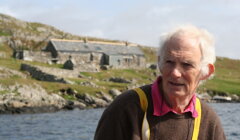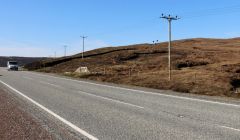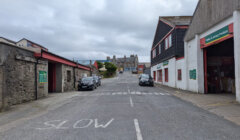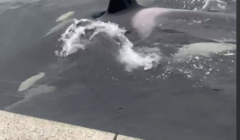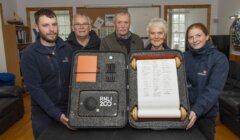Community / Fence plans cause museum access concern
PLANS to erect fencing and “stop-up” a road in a builder’s merchant site in Lerwick could disrupt maintenance of the Shetland Museum and stop historic boats from berthing at Hays Dock, it has been claimed.
Shetland Amenity Trust is calling for a reconsideration of the design of proposed fencing and gates at Huw’s Gray to maintain access to the Shetland Museum, which it operates.
Its chief executive Hazel Sutherland said in a letter to Shetland Islands Council’s planning service that the trust has used an access route from Freefield Road to the museum for more than 20 years, and is the only way equipment such as scaffolding as well as boats can be transported to the site.
Huws Gray recently lodged plans to tackle what it said is a health and safety issue at its base in Lerwick with pedestrians walking through its site.
It is seeking to erect a 2.4 metre security fencing at the site and also realign part of the core path there to alongside the quayside.
The current core public path runs through the Huws Gray site via Freefield Road – which connects the site to Commercial Road – before going past the museum. People can also walk around the site along the waterfront from the Shetland Museum.
Huws Gray is also seeking the ‘stopping up’ of Freefield Road, where it would cease to be a public road.
The merchant occupies a number of buildings and yards in the area.
However, Sutherland said Shetland Amenity Trust – which also has offices at Garthspool – objects to the plans as they currently stand.
The trust has cited sections of Shetland’s local development plan which state that development “should not adversely affect areas, buildings or structures of archaeological, architectural or historic interest” and “should not have a significant adverse effect on existing uses”.
Become a member of Shetland News
Sutherland said trust staff regularly move between the two SAT operated buildings at either side of the site, either through the area or at the pier side.
“From an operational point of view, the safety of people using the site is obviously paramount,” she wrote.
However, she said the plans as they stand would mean that some aspects of SAT’s services would be “unable to continue”.
“We would strongly advocate for a safe access route to be retained from Freefield Road through to the north side of the Museum and Archives facilities, and for that natural access route to be protected through a condition of planning,” she wrote.
Sutherland added that due to the constraints of the area around the museum “the only way in which equipment and materials can be safely taken to site, such as scaffolding, is through the Huws Gray”.
She said over the years owners of that site have been “incredibly supportive in enabling Shetland Amenity Trust access for building works”.
“Closing off the access through the site would mean the Shetland Museum and Archives maintenance works would be significantly constrained, to the detriment and expected lifespan of one of Shetland’s iconic buildings,” she wrote.
Sutherland said fencing off the route through to Freefield Road would effectively block off the movement of boats to and from Hay’s Dock when they need to be transported on land.
She added that the pier store holds equipment and materials for the Swan Trust, and closing off the land-side route “may mean that they have to relocate their base, which may be disruptive to their operations”.
The chief executive also highlighted how the Junior Up Helly Aa galley is taken through the Freefield access when the jarl squad visits the museum.
“We would therefore request that the design of the fencing and gates be reconsidered to maintain access and retain a through route that will enable the full operations in place at Shetland Museum and Archives to continue,” Sutherland said.
“This access route has been in place for more than 20 years and there has been no issues raised to date. Shetland Amenity Trust therefore operates as if there is a right of access in place. Shetland Amenity Trust would always request access through the Huws Gray site, to support safe systems of work.”
The SAT chief executive also questioned the safety of having the core path moved to alongside the water, and if there would be an alternative public access route in the event of it being unsafe due to weather, such as high tide or snow.
In its own planning submissions, Huws Gray highlighted how the site has no means of enclosure or controlled access at the moment.
“As is typical with the day to day operations of a builders merchant, there are materials stacked throughout the site and regular movement of forklift trucks and other associated operational vehicles,” it added.
The company added that the lack of security fencing and a gate at the entrance to the site is “creating a health and safety issue”.
This is being exacerbated by cruise ship visitors being taken on tours through the site and accessing it at the southern entrance at Freefield Road, which is outwith the core path designation, Huws Gray said.
It added: “The local importance of the existing core path, as part of the local outdoor access network and for local connectivity, is acknowledged.
“It is proposed that the existing section of the core path that is currently routed along Freefield Road will be re-aligned to along the quayside, to align with the existing public right of way.
“This will ensure that pedestrian access and continuity of the core path is maintained.”
Become a member of Shetland News
Shetland News is asking its many readers to consider paying for membership to get additional features and services: -
- Remove non-local ads;
- Bookmark posts to read later;
- Exclusive curated weekly newsletter;
- Hide membership messages;
- Comments open for discussion.
If you appreciate what we do and feel strongly about impartial local journalism, then please become a member of Shetland News by either making a single payment, or setting up a monthly, quarterly or yearly subscription.






































